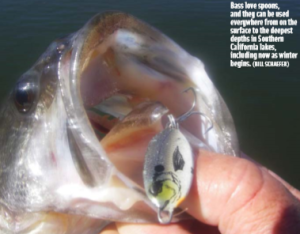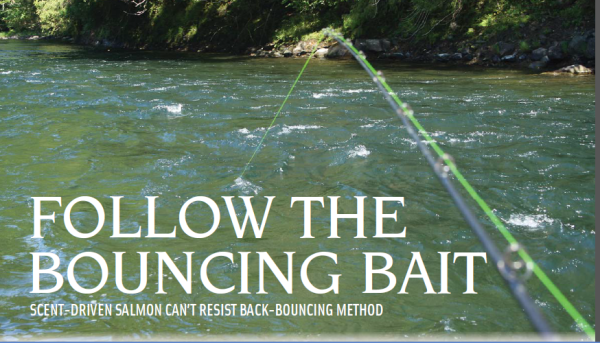Don’t Forget the Silverware
WINTER BASS LOVE THE MOVEMENT OF SPOONS
–By Capt. Bill Schaefer
It was a warm Southland summer and fall seems to be headed in the same direction.
Bass have been chasing shad and the topwater action at most Southern California lakes has been the ticket to success. As long as the temperatures stay up, the topwater fishing will continue. But even as the baitfish sink out and are not relating to the surface as much, you can still chase the bass; they are just a little deeper.
As we know, the bass start to chase shad in the late summer and fall, and it is these balls of bait that keep them healthy, happy and full through the winter. As on any lake, if you can find the baitfish, you can usually find bass close by. Spooning can be effective through the end of summer until early spring, but will work almost year-round. It’s a trick you need to keep in your arsenal.
I want to tell you that you shouldn’t be afraid of the technique of spooning. Don’t be discouraged that this type of fishing can be too hard or complicated to learn or use. It does take some practice, but no more than any other technique.
Also, it is not always a deep-water technique. It can be just as effective in more shallow waters as well. Practice and patience will make you a better spoon fisherman. Your first bass with a spoon will – and apologies for the pun – have you hooked.
Where should you use them, you may be asking? Well, spoons can be used everywhere from on the surface to the deepest depths. There are few lures that can rival a spoon in deep water, especially when the bass are starting to get finicky. They are great all-around lures for when bass are suspended in sunken treetops, around deep rock piles or schooledup and chasing bait. Brush piles in deep water, old river channels and stumps can also hold fish; the spooning method can be deadly in taking bass from around them.
Choosing the correct spoons can be important as well. You want to come close to the size of the shad you are trying to emulate. Too large a spoon or too small of one can keep you from getting a reaction bite. Too much flash or not enough can matter as well. The action of the spoon or the flutter on the fall can make a bass eat or not bother with the lure. Matching the hatch, as they say, can make all the difference in the world.
Technique is important and there are many different ways to work a spoon. It all depends on where you are fishing with the bait. You drop the spoon down until you think you are in the same zone the fish are feeding in. Put the reel in gear, pointing the rod tip at the water, and snap the rod tip up almost as if you were setting the hook. Next, drop the rod tip back towards the water. This lets the spoon flutter down. If you detect a bite, set the hook; if you miss the feel of the bite, the next snap of the rod sets the hook.
Just about every lake in California has a shad population the bass are keying on and spooning is the technique to use this time of year. As I mentioned, you can almost spoon year-round, but as we head towards winter, it is a preferred method by many professional bass anglers. CS



